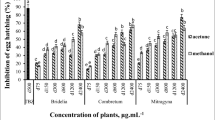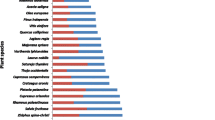Abstract
Resistance to anthelminthics is common due to intensive and incorrect use. In searching for alternatives, extracts of banana plant were evaluated for egg hatching inhibition and fecal egg count reduction of sheep nematodes. Aqueous extracts of the leaf, pseudostem, and heart of the banana plant cv. Prata anã were tested at concentrations of 0.31, 0.62, 1.25, 2.5, 5.0, and 10.0 mg ml−1 in egg hatching inhibition tests. For in vivo analysis, aqueous extracts were evaluated at dosages calculated according to the 10% lethal dose derived from acute toxicity testing in mice. Efficacy was evaluated at two time periods following oral administration. For the banana extracts at 2.5 mg ml−1, egg hatching was significantly fewer than the negative control, with an LC50 and LC90 of 0.19 and 0.84 mg ml−1, respectively. In vivo analysis for weeks 1 and 2 following a single treatment with aqueous leaf extract showed 33.1% and 32.5% anthelminthic efficacy, respectively. Further research on higher dosages with more frequent administration is needed to evaluate the potential for utilizing banana plant residues in gastrointestinal nematode control.
Similar content being viewed by others
Abbreviations
- DM:
-
Dry matter
- EHI:
-
Egg hatching inhibition
- FEC:
-
Fecal egg count
- GNIs:
-
Gastrointestinal nematodes
- LC:
-
Lethal concentration
- LD:
-
Lethal dose
References
Brunet S, Fourquaux I, Hoste H (2011) Ultrastructural changes in the third stage, infective larvae of ruminant nematodes treated with sainfoin (Onobrychis viciifolia) extract. Parasitol Internat 60(4):419–424
Camurça-Vasconcelos ALF, Bevilaqua CML, Morais SM, Maciel MV, Costa CTC, Macedo ITF, Oliveira LMB, Braga RR, Silva RA, Vieira LS, Navarro AMC (2007) Anthelminthic activity of croton zehntneri and lippiasidoides essential oils. Vet Parasitol 148:288–294
Coles GC, Bauer C, Borgsteede FHM, Geerts S, Klei TR, Taylor MA, Waller PJ (1992) World Association for the Advancement of Veterinary Parasitology (W.A.A.V.P.) methods for the detection of anthelminthic resistance in nematodes of veterinary importance. Vet Parasitol 44:35–44
Costa CTC, Morais SM, Bevilaqua CML, Souza MMC, Leite FKA (2002) Ovicidal effect of Mangifera indica L. seeds extracts on Haemonchus contortus. Brazil J Vet Parasitol 11:57–60
Furtado SK (2006) Alternativas fitoterápicas para o controle da verminose ovina no estado do Paraná: testes in vitro e in vivo. Thesis, Universidade Federal do Paraná, Brasil
Githiori JG, Athanasiadou S, Thamsborg SM (2006) Use of plants in novel approaches for control of gastrointestinal helminths in livestock with emphasis on small ruminants. Vet Parasitol 139:308–320
Gordon HM, Whitlock HV (1939) A new technique for counting nematode eggs in sheep faeces. J Coun Sci Ind Res Austr 12:50–52
Hoste H (2006) The effects of tannin-rich plants on parasitic nematodes in ruminants. Trends Parasitol 22:253–261
Jackson F, Coop RL (2000) The development of anthelminthic resistance in sheep nematodes. Parasitol 120:95–107
Kahn LP, Diaz-Hernandez A (2000) Tannins with anthelminthic properties. In: Brooker JD (ed) Tannins in livestock and human nutrition: proceedings of an international conference. Australian Centre for International Agricultural Research, Adelaide, pp 130–139
Hernández-Villegas MM, Borges-Argáez R, Rodriguez-Vivas RI, Torres-Acosta JFJ, Méndez-Gonzalez M, Cáceres-Farfana M (2011) Ovicidal and larvicidal activity of the crude extracts from Phytolaccaicosandra against Haemonchus contortus. Vet Parasitol 179:100–106
Klimpel S, Abdel-Ghaffar F, Al-Rasheid KA, Aksu G, Fischer K, Strassen B, Mehlhorn H (2010) The effects of different plant extracts on nematodes. Parasitol Res 108:1047–1054
Lange KC, Olcott DD, Miller JE, Mosjidis JA, Terrill TH, Burke JM, Kearney MT (2006) Effect of Sericea lespedeza (Lespedeza cuneata) fed as hay, on natural and experimental Haemonchus contortus infections in lambs. Vet Parasitol 141:273–278
Maciel MV, Morais SM, Bevilaqua CML, Camurca-Vasconcelos ALF, Costa CTC, Castro CMS (2006) Ovicidal and larvicidal activity of Melia azedarach extracts on Haemonchus contortus. Vet Parasitol 140:98–104
Marie-Magdeleine C (2009) Etude des propriétés anthelminthiques de quelques ressources végétales tropicales en élevage de ruminants. PhD Antilles Guyane, Guadeloupe
Marie-Magdeleine C, Boval M, Philibert L, Borde A, Archimède H (2010) Effect of banana foliage (Musa paradisiaca) on nutrition, parasite infection and growth of lambs. Livest Sci 131:234–239
Marley CL, Cook R, Barrett J, Keatinge R, Lampkin NH (2003) The effect of birdsfoot trefoil (Lotus corniculatus) and chicory (Cichoriumintybus) on parasite intensities and performance of lambs naturally infected with helminth parasites. Vet Parasitol 112:147–155
Matos FJ (1997) A Introdução à fitoquímica experimental. UFC, Fortaleza
Melo ACFL, Bevilaqua CML (2002) Resistência anti-helmíntica em nematódeos de pequenos de ruminantes: uma revisão. Ciência Animal 12:35–45
Nery PS, Nogueira FA, Martins ER, Duarte ER (2010) Effect of Anacardium humile leaf extracts on the larval development of gastrointestinal nematodes of sheep. Vet Parasitol 171:361–364
Oliveira DB, Amorim A, Braga MM, Mattos Júnior DG, Almosny NRP (1997) Atividade anti-helmíntica da bananeira (Musa spp) em caprinos. Congresso Brasileiro Parasitol 15:65
Oliveira LMB, Bevilaqua CML, Costa CTC, Macedo ITF, Barros RS, Rodrigues ACM, Camurça-Vasconcelos ALF, Morais SM, Lima YC, Vieira LS, Navarro AMC (2009) Anthelminthic activity of Cocos nucifera L against sheep gastrointestinal nematodes. Vet Parasitol 159:55–59
Oliveira LN, Duarte ED, Nogueira FA, Silva RB, Faria Filho DE, Geraseev LC (2010) Eficácia de resíduos da bananicultura sobre a inibição do desenvolvimento larval em Haemonchus spp. provenientes de ovinos. Ciência Rural 40:488–490
Olivo CJ, Pereira LET, Carvalho NM, Vogel FF, Heinzmann BM, Neves AP (2007) Use of the banana plant (Musa spp.) for the control of parasites in domestic animals: from empiricism to science. Livest Res Rural Dev 19(11). http://www.lrrd.org/lrrd19/11/oliv19158.htm. Accessed 1 Feb 2011
Rates SMK (2001) Plants as source of drugs. Toxicon 39:603–613
SAEG–Sistema para Análises Estatísticas, Versão 91 (2007) Fundação Arthur Bernardes, Viçosa
Sokerya S, Rodriguez L (2001) Foliage from cassava, Flemingia macrophylla and bananas compared with grasses as forage sources for goats: effect on growth rate and intestinal nematodes. Livest Res Rural Dev 13(2). http://www.lrrd.org/lrrd13/2/soke132.htm. Accessed 13 Feb 2011
Torres-Acosta JFJ, Hoste H (2008) Alternative or improved methods to limit gastro-intestinal parasitism in grazing sheep and goats. Small Rumin Res 77:159–173
Ueno H, Gonçalves PC (1998) Manual paradiagnóstico das helmintoses de ruminantes. Japan Internatinal Cooperation Agency, Salvador
Vieira LS (2003) Alternativas de controle da verminosegastrintestinal dos pequenosruminantes. Embrapa CNPC Brazil, Sobral
Vieira LS, Cavalcante ACR, Pereira MF, Dantas LB, Ximenes LJF (1999) Evaluation of anthelminthic efficacy of plants available in Ceará State, Northeast Brazil, for the control of goat gastrointestinal nematodes. Rev Med Vet 150:447–452
United Nations Conference on Trade and Development (UNCTAD) (2011) Market: banana production. http://www.unctad.org/infocomm/anglais/banana/market.htm. Accessed 13 Feb 2011
Acknowledgments
We thank the Fundação de Amparo à Pesquisa de Minas Gerais (FAPEMIG), Banco do Nordeste, and Conselho Nacional de Desenvolvimento Científico e Tecnológico (CNPq) of Brazil for providing financial support. The authors are also grateful to Coordenação de Aperfeiçoamento de Pessoal de Nível Superior (CAPES, Brazil), PRPq/UFMG, and to Associação Central dos Fruticultores do Norte de Minas (Abanorte).
Author information
Authors and Affiliations
Corresponding author
Rights and permissions
About this article
Cite this article
Nogueira, F.A., Oliveira, L.N., da Silva, R.B. et al. Anthelminthic efficacy of banana crop residues on gastrointestinal nematodes of sheep: in vitro and in vivo tests. Parasitol Res 111, 317–323 (2012). https://doi.org/10.1007/s00436-012-2842-9
Received:
Accepted:
Published:
Issue Date:
DOI: https://doi.org/10.1007/s00436-012-2842-9




